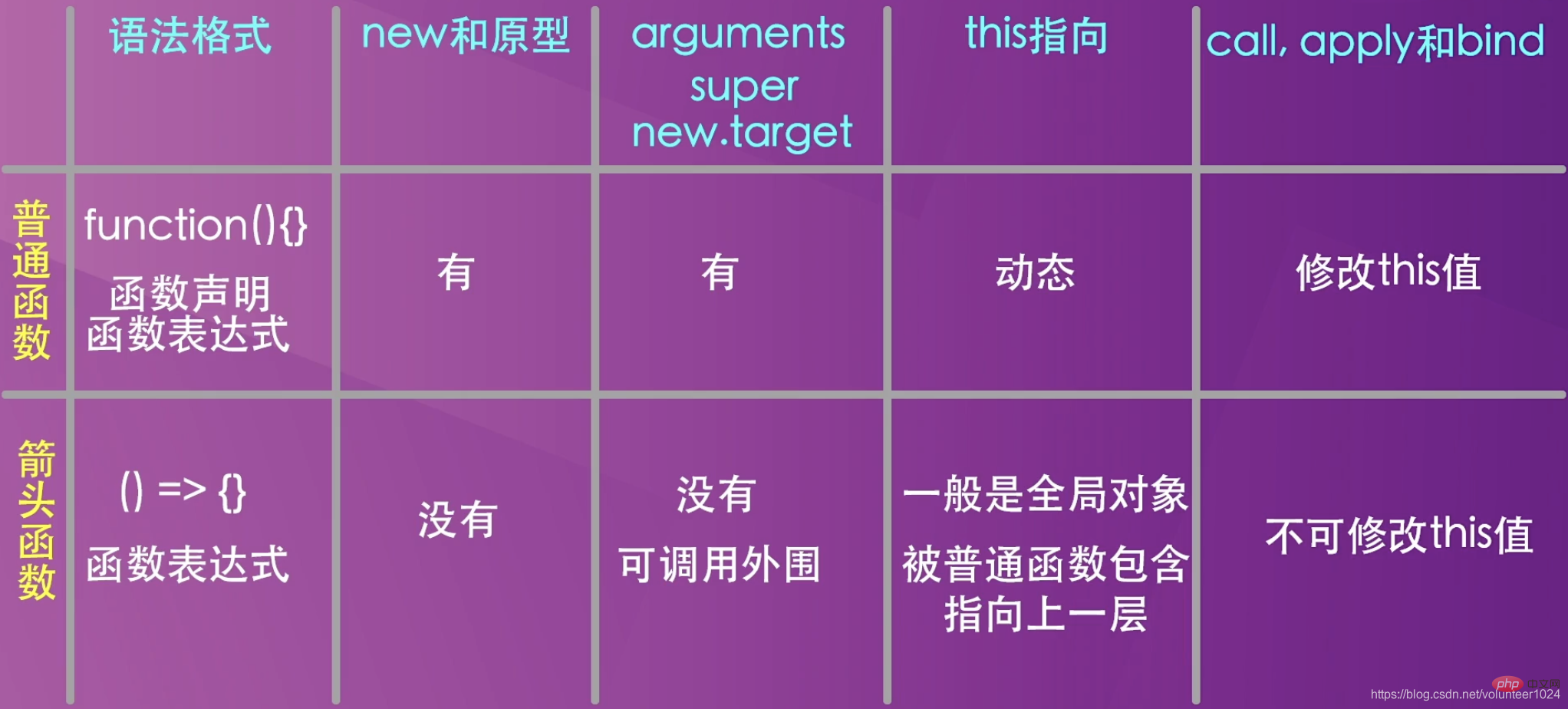實例程式碼之ES6箭頭函數實踐
- WBOYWBOYWBOYWBOYWBOYWBOYWBOYWBOYWBOYWBOYWBOYWBOYWB轉載
- 2022-08-08 10:26:021040瀏覽
本篇文章為大家帶來了關於javascript的相關知識,其中主要介紹了箭頭函數應用的相關問題,箭頭函數表達式更適用於那些本來需要匿名函數的地方,並且它不能用作構造函數,下面一起來看一下,希望對大家有幫助。

【相關推薦:javascript影片教學、web前端】
##簡介箭頭函數表達式的語法比函數表達式更簡潔,也沒有自己的this,arguments,super或new.target。箭頭函數表達式更適用於那些本來需要匿名函數的地方,並且它不能用作構造函數。 ---- MDN基礎用法
參數表示
(param1, param2, …, paramN) => { statements }
(param1, param2, …, paramN) => expression
//相当于:(param1, param2, …, paramN) =>{ return expression; }
// 当只有一个参数时,圆括号是可选的:
(singleParam) => { statements }
singleParam => { statements }
// 没有参数的函数应该写成一对圆括号。
() => { statements }
傳回值表示let add1 = (num1, num2) => {
num1 + num2
};
let add2 = (num1, num2) => {
return num1 + num2
};
let add3 = (num1, num2) => (num1 + num2);
let add4 = (num1, num2) => num1 + num2;
console.log(add1(2, 3)); // undefined
console.log(add2(2, 3)); // 5
console.log(add3(2, 3)); // 5
console.log(add4(2, 3)); // 5
進階//加括号的函数体返回对象字面量表达式:
let func = () => ({foo: 'bar'})
console.log(func()); // {foo: 'bar'}
//支持剩余参数和默认参数
(param1, param2, ...rest) => { statements }
(param1 = defaultValue1, param2, …, paramN = defaultValueN) => {
statements }
//同样支持参数列表解构
let f = ([a, b] = [1, 2], {x: c} = {x: a + b}) => a + b + c;
f(); // 6
this
- 如果必須使用匿名函數,或者inline 回呼函數,使用箭頭函數。 eslint: prefer-arrow-callback, arrow-spacing
如果函數邏輯相當複雜,應使用命名函數
why?語法更簡潔,並且this更符合預期
// bad[1, 2, 3].map(function (x) {
const y = x + 1;
return x * y;});// good[1, 2, 3].map((x) => {
const y = x + 1;
return x * y;});
如果函數體只有一條語句,且該語句不會產生副作用。使用簡寫方式,隱含回傳;或使用完整寫法,顯式return。
// bad
[1, 2, 3].map(number => {
const nextNumber = number + 1;
`A string containing the ${nextNumber}.`;
});
// good
[1, 2, 3].map(number => `A string containing the ${number}.`);
// good
[1, 2, 3].map((number) => {
const nextNumber = number + 1;
return `A string containing the ${nextNumber}.`;
});
// good
[1, 2, 3].map((number, index) => ({
[index]: number,
}));
// No implicit return with side effects
function foo(callback) {
const val = callback();
if (val === true) {
// Do something if callback returns true
}
}
let bool = false;
// bad
foo(() => bool = true);
// good
foo(() => {
bool = true;
});
#why?函數開頭和結束更明確
// bad['get', 'post', 'put'].map(httpMethod => Object.prototype.hasOwnProperty.call( httpMagicObjectWithAVeryLongName, httpMethod, ));// good['get', 'post', 'put'].map(httpMethod => ( Object.prototype.hasOwnProperty.call( httpMagicObjectWithAVeryLongName, httpMethod, )));
// bad[1, 2, 3].map((x) => x * x);// good[1, 2, 3].map(x => x * x);// good[1, 2, 3].map(number => (
`A long string with the ${number}. It’s so long that we don’t want it to take up space on the .map line!`));// bad[1, 2, 3].map(x => {
const y = x + 1;
return x * y;});// good[1, 2, 3].map((x) => {
const y = x + 1;
return x * y;});
// badconst itemHeight = item => item.height > 256 ? item.largeSize : item.smallSize;// badconst itemHeight = (item) => item.height > 256 ? item.largeSize : item.smallSize;// goodconst itemHeight = item => (item.height > 256 ? item.largeSize : item.smallSize);// goodconst itemHeight = (item) => {
const { height, largeSize, smallSize } = item;
return height > 256 ? largeSize : smallSize;
簡單結論- #箭頭函數不能用new來建立建構函式的實例,普通函數可以(因為箭頭函數創建的時候程式不會為它創建construct方法,也就是沒有構造能力,用完就丟掉了,不像普通函數重複利用,因此也不需要構造函數原型,也就是不會自動生成prototype屬性)
- 程式不會給箭頭函數建立arguments物件
- #普通函數中的this是動態的,而箭頭函數中的this指向的是緊緊包裹箭頭函數的那個物件(定義時決定的)
- 箭頭函數不能透過bind、call、apply來改變this的值,但依然可以呼叫這幾個方法(只是this的值不受這幾個方法控制)
以上是實例程式碼之ES6箭頭函數實踐的詳細內容。更多資訊請關注PHP中文網其他相關文章!
陳述:
本文轉載於:csdn.net。如有侵權,請聯絡admin@php.cn刪除
上一篇:ES6中箭頭函數的詳細梳理下一篇:ES6中箭頭函數的詳細梳理

